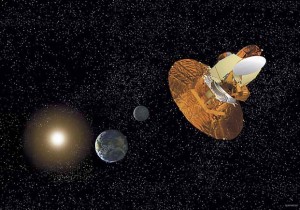Introduction to Cosmology (Physics 371)
Sean Carroll, Physics Department, University of Chicago
Spring quarter, 2006
(the WMAP [Wilkinson Microwave Anisotropy Probe] satellite, from the WMAP Home Page)
Description
Physics 371 is a graduate-level introduction to cosmology, the study of the structure and evolution of the universe. As a post-candidacy 300-level course, it is appropriate for students in all specialties, with only standard first-year courses as prerequisites. The course will describe the basics of the standard Big-Bang model and some currently popular extensions thereof. Beginning with an overview of our observed universe, we will discuss the basics of relativistic cosmology, thermodynamics and relic abundances, scalar-field cosmology including dark energy and inflation, large-scale structure, and the cosmic microwave background.
Grading: The final grade will be based 50% on problem sets and 50% on a final paper. You are encouraged to talk to your fellow students about the problem sets, but make sure that what you hand in is produced by you.
Here is the PDF file for something handed out in class: A No-Nonsense Introduction to General Relativity.
Here are guidelines for the final paper (pdf).
Dates
Classes will meet Tuesdays and Thursdays from 1:30 to 2:50 p.m., in Kersten 103. The first day of class is Tuesday 28 March.
Proposals for the final papers are due in class on Thursday May 4th. The papers themselves will be are due at noon on Friday, June 2, in my office (RI262).
Personnel
Sean Carroll, Professor
Jing Shu, Grader
Outline (subject to change)
- Relativistic cosmology
- General relativity overview: metrics, geodesics, energy-momentum, Einstein’s equation
- Homogeneous and isotropic cosmology
- Redshifts and distances
- Friedmann equation and solutions
- Particle interactions and abundances
- Standard Model overview: fermions, gauge bosons, Higgs
- Interactions and cross-sections
- Thermodynamics and relic abundances
- Hot and cold dark matter
- Neutrino cosmology
- Recombination
- Nucleosynthesis
- Baryogenesis
- Scalar-field cosmology
- Lagrangian field theory
- Dark energy: observations, candidates
- Inflation: motivations, models, reheating
- Axions and moduli
- Topological defects: walls, strings, monopoles
- Perturbations and structure
- Gravitational instability
- Power spectrum
- Evolution of structure
- CMB anisotropies
- Primordial perturbations from inflation
Problem Sets
Problem sets will be handed out on Thursdays, due the following Thursday. These are pdf files.
- Problem Set One, due 13 April.
- Problem Set Two, due 20 April.
- Problem Set Three, due 27 April.
- Problem Set Four, due 4 May.
- Problem Set Five, due 11 May.
- Problem Set Six, due 18 May.
- Problem Set Seven, due 1 June.
Books
Click on the titles to see the amazon.com entry for each book. You can even buy them online if you like.
- Edward W. Kolb and Michael S. Turner, The Early Universe (Perseus, 1993). (Required.)
This is the main text, although we won’t follow it slavishly. It provides a direct and accessible introduction to the most important ideas in the toolbox of a working early-universe cosmologist. (Written before the discovery of CMB anisotropies, the sections on perturbations and structure are less up-to-date.) - John A. Peacock, Cosmological Physics (Cambridge, 1998).
More up-to-date than K&T, but burdened by an overwhelming amount of preliminary material. A very useful reference. - Scott Dodelson, Modern Cosmology (Academic Press, 2003).
An excellent and up-to-date book. Interested primarily in the evolution of perturbations and CMB anisotropies, with a lot of GR-based calculations, which is why we aren’t using it for this course. - Andrew R. Liddle and David H. Lyth, Cosmological Inflation and Large-Scale Structure (Cambridge, 2000).
A focused introduction on cosmological perturbations, from their origin in inflation to their observation as CMB anisotropies and large-scale structure. - P. J. E. Peebles, Principles of Physical Cosmology (Princeton, 1993).
A comprehensive overview of numerous topics in physical cosmology. (“Physical” cosmology is, I think, supposed to distinguish the down-to-earth style favored by astrophysicists from the speculative flights of fancy indulged in by particle theorists.) - Alan H. Guth, The Inflationary Universe (Perseus, 1998);
Dennis Overbye, Lonely Hearts of the Cosmos (Little, Brown and Company, 1999).
Two great popular-level books on modern cosmology.
Other Resources
Here are some review articles you might find useful:
- “TASI Lectures: Introduction to Cosmology”, M. Trodden and S.M. Carroll, astro-ph/0401547.
- “The Cosmological Constant”, S.M. Carroll, astro-ph/0004075.
- “Introduction to Cosmology”, D.H. Lyth, astro-ph/9312022.
- “Particle Physics and Cosmology”, E.W. Kolb, astro-ph/9403007.
- “Big Bang nucleosynthesis and physics beyond the Standard Model”, S. Sarkar, hep-ph/9602260.
- “The Physics of Microwave Background Anisotropies”, W. Hu, N. Sugiyama, and J. Silk, astro-ph/9604166.
- “The Cosmic Microwave Background and Particle Physics”, M. Kamionkowski and A. Kosowsky, astro-ph/9904108.
And here are links to some other relevant sites:
- Kavli Institute for Cosmological Physics web page. You are encouraged to attend the Friday lunchtime informal talks, which will give a flavor of current cosmological research.
- Wayne Hu’s web pages. Full of introductory info on cosmology, especially the CMB.
- Ned Wright’s cosmology tutorial. Good introduction to the basics.
- Andrew Hamilton’s cosmology links.
- astro-ph, the astrophysics archive at arxiv.org. Here you will find online copies of current research papers.
- SPIRES, the literature database from SLAC. Provides a way to search for papers by author, title, and references.

Hello Sean
Thank you so much for this – it is very interesting and helpful.
I think the link to Andrew Hamilton’s cosmology links has changed.
Looks like it is https://jila.colorado.edu/~ajsh/bh/cosmology.html
Many thanks
Chris